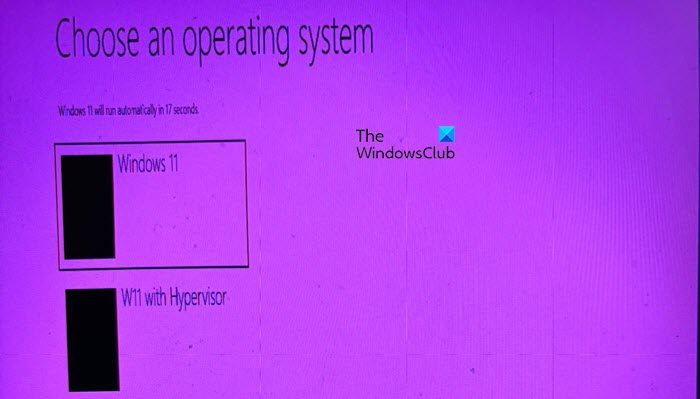Microsoft Hyper-V, VirtualBox, and VMware Workstation are three of the most popular hypervisor platforms for Windows devices. However, they are incompatible with each other, so you might not be able to run all of them on a single host machine. In this post, we are going to unravel the reason for this incompatibility and see how to run Hyper-V, VirtualBox, and VMware on the same computer.
Run Hyper-V, VirtualBox, and VMware on the same computer
Before we see how you can run Hyper-V, VirtualBox, and VMware on the same computer, we should first learn why incompatibility exists.
When the hypervisor is enabled during the computer’s boot process, only Type 1 hypervisors such as Hyper-V have the capability to run virtual machines. In order to enable virtual machine functionality on Type 2 hypervisors such as VirtualBox or VMware, the hardware hypervisor must be deactivated. The Type 1 hypervisor is directly installed on the bare metal server, allowing direct access to the hardware resources. Consequently, it is often referred to as a bare metal hypervisor. Whereas, the Type 2 hypervisor is an application installed within the host operating system.
Even though there is no direct way to run Hyper-V, VirtualBox, and VMware on the same host computer, there are a few workarounds that we can try.
- Easily enable or disable Hypervisor
- Use HyperVSwitch to quickly turn Hypervisor on or off
- Use two separate instances to boot
Let us discuss them in detail.
1] Easily enable or disable Hypervisor

If you want your host machine to be compatible with Hyper-V, you need to enable Hypervisor. But to make it compatible with VirtualBox and/or VMware, you need to disable it.
In this guide, we will see how you can quickly do that.
- First of all, open the Command Prompt as an administrator.
- Then, run bcdedit to list all the boot entries on your computer. You need to run find your operating system where the identifier will be set as {current},
- Also, check the hypervisorlaunchtype field, if it is set to AUTO, the feature is enabled, whereas, if it is set to OFF, it is disabled.
- In case, the Hypervisor is enabled, you will be able to run Hyper-V, but to run VirtualBox or VMWare, run the following command to disable the feature.
bcdedit /set {current} hypervisorlaunchtype off
- To enable it and make your system compatible with Hyper-V, run the command below.
bcdedit /set {current} hypervisorlaunchtype auto
You will have to do it time and again whenever you want to switch between the two variants of hypervisor.
2] Use HyperVSwitch to quickly turn Hypervisor on or off
The Hyper-V Switch reads and writes the BCD file. It shows the current state and lets you easily switch Hyper-V on or off with a single click. You’ll need to restart your computer after making the switch. This is because to change Hyper-V usage, Windows needs to start without permanent virtualization or as a virtualized guest from the beginning. Remember, you can only access and change this information with Administrator privileges. So, we recommend you go to github.com to learn more about this tool and download it.
3] Use two separate instances to boot
If you do not like either of the methods mentioned above, let us discuss a permanent solution. To make the process seamless, we can create two separate booting instances—Win 11 with Hypervisor and Win 11 without Hypervisor.

So, first of all, open the Command Prompt as an admin and then run bcdedit to know the start of your hypervisor.
If the ‘Hypervisor’ is ‘ON’, run bcdedit /copy {current} /d "W11 without Hypervisor". But if it is disabled, run bcdedit /copy {current} /d "W11 with Hypervisor".
It will generate a string that you need to copy and paste somewhere as it is a new boot entry and is added to the list.
Now, run the following command to change the state of that boot entry to OFF if it’s ON; to ON if it is Off.
bcdedit /set {copied-identifier-value} hypervisorlauncher off
bcdedit /set {copied-identifier-value} hypervisorlauncher on
Make sure to replace the value ‘{copied-identifier-value}’ with the string value we asked you to copy earlier.

Now when you restart your computer, you will be asked in which boot instance you want to log in.
That’s it!
Read: How to enable Hyper-V on Windows 365 Cloud PC?
Can you run Hyper-V and VMware on same machine?
You can run Hyper-V and VMware on the same machine but not simultaneously. You can either create two separate instances of your operating system, one will have the hypervisor turned off, whereas, the other one will keep it enabled. Alternatively, switch between the two modes using the Command Prompt or HyperVSwitch app.
Read: How to make Hyper-V virtual machine launch automatically at startup
Can I use VirtualBox and VMware together?
Yes, Oracle VirtualBox and VMware Workstation can coexist and run simultaneously on a single host as both of them are type 2 hypervisors. Just make sure you have enough memory to distribute between the two.
Leave a Reply